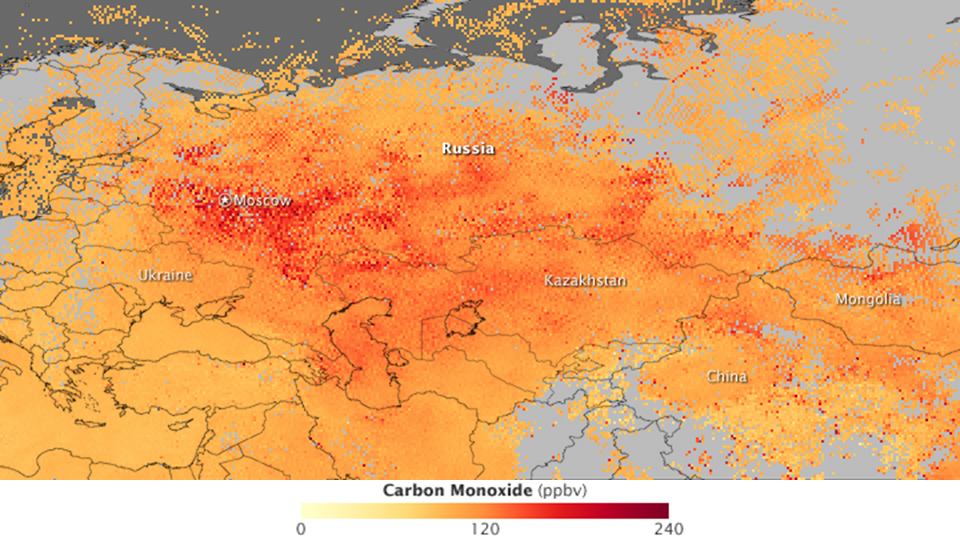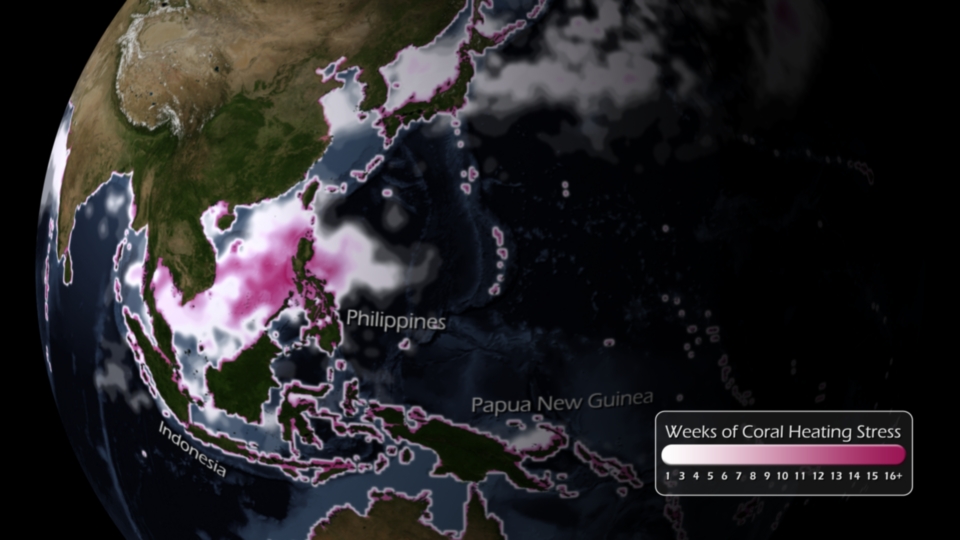Updated 07 September 2010

After record warm temperatures, drought, wildfires, and poor air quality during July 2010, the dismal conditions continued through mid-August across western Russia. According to a report in RIA Novosti, the head of the Russian Meteorological Service said that the country experienced "the longest unprecedented heat wave for at least 1,000 years". Unofficial estimates placed the death toll near 15,000 people across Russia, with 7,000 in Moscow alone. At the beginning of August, 676 square miles (1,740 square km) were burning with over 600 active fires. Outside Moscow, Russia's most deadly wildfire since 1972 charred homes and farmland. A major impact from the fires and heat were the loss of wheat crops. Russia is the world's third-largest exporter of wheat and had recently slashed its harvest forecast from 90 million metric tons to 60 million metric tons. Due to the shortage, the 18 million metric tons that were to be exported would no longer leave the country—threatening wheat prices worldwide. Economists predicted the heat and fire would cause over $15 billion in loss of economic growth this year. Military and nuclear installations were also threatened across the country by the fires, prompting the emergency transport of missiles and nuclear fuels out of harm's way. The average daily maximum temperature in Moscow for early August is 69°F (21°C); during the first half of August 2010, temperatures were 27°F (15°C) above average. The two-month long heatwave finally broke on August 19th as a cold front moved across western Russia, bringing rain and much cooler temperatures and clearing the thick smog that had hovered over Moscow for weeks.
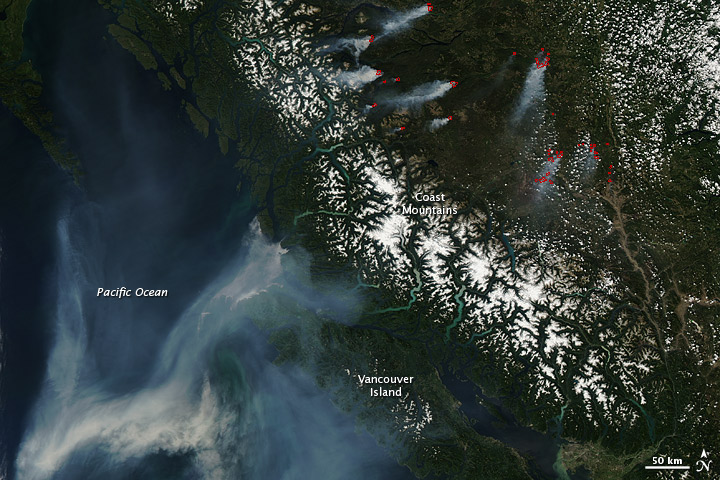
British Columbia, Canada Fires
13 August 2010
Image Credit: NASA
Drought conditions and a heat wave engulfed the northern half of British Columbia, Canada during the first half of August. The region received only 25 to 50 percent of its average rainfall during June and July. Several rivers were at 10 to 20 year lows, threatening local fish stocks and water supplies. Under a ridge of high pressure, many high temperature records were broken. Squamish reached 98.1°F (36.7°C) on the 14th, shattering the previous record set in 2008 by 9°F (5°C). The hot weather sparked 25 new wildfires on the 14th and 15th (270 burning in total) as nearly 75 percent of British Columbia was under high or extreme wildfire danger. The heatwave also extended northwest into Alaska. On August 15th, Fairbanks recorded a high temperature of 91°F (32.8°C), breaking the old record of 86°F (30°C) previously set in 1926. This marks only the fifth time that an August temperature surpassed 90°F (32.2°C) in the city since 1904, when record keeping began.

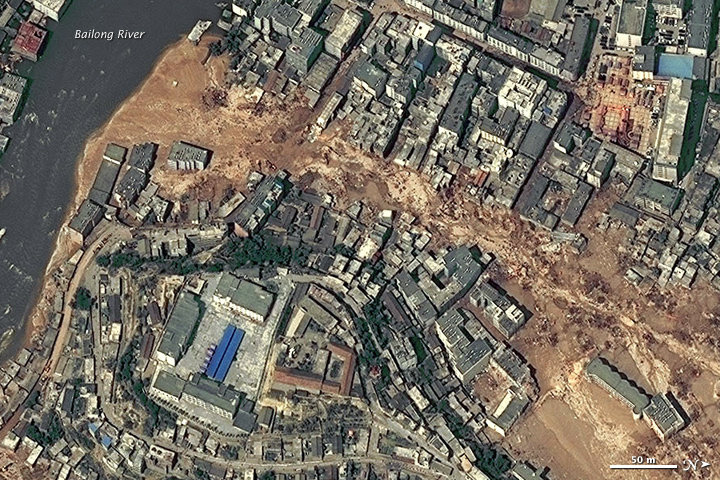
Zhouqu Flooding
10 August 2010
Image Credit: DigitalGlobe
Two separate heavy rainfall events during the first half of August killed over 1,500 people across China. The first event in the northeastern province of Jilin occurred August 1st–4th when record rainfall caused rivers and reservoirs to breach their banks. Flooding overwhelmed major roads after some portions of the Songhua River reached water levels twice as high as normal. The flooding was dubbed the worst in that region of China in over a decade as the death toll surpassed 100 people. The second extreme event occurred on August 8th in a remote region of the northwestern province of Gansu. In Zhouqu county, several villages were leveled by landslides triggered by the rainfall. Water-borne diseases were a significant threat in the region, as water supplies were contaminated. Very warm temperatures hampered rescue efforts as daily maximum temperatures hovered around 93°F (34°C). While torrential rains were the direct cause, tree cutting that left the dry hills exposed and the weakening of cliff faces by a massive 2008 earthquake were seen as contributing factors. At least 1,435 people were killed in the landslides, while 330 people remained missing. Major precipitation events continued into the second half of August. Days of heavy rainfall deluged northeastern China and North Korea, causing the Yalu River (known as the Amnok in North Korea) to overflow its banks on August 23rd. The flooding led to the evacuation of more than 250,000 people in Dandong, a city in China's Lionang Province, and at least 5,150 residents in Sinuiju, North Korea, the city on that sits opposite of Dandong on the border between the two countries. Four people were killed during this event in China as the country continued to exprerience its worst floods in more than a decade. La Niña conditions—which officially began in July—were thought to be a contributing factor to the unusually heavy rains during this monsoon season.
Major flooding in Central Europe on August 9th killed at least 11 people and damaged hundreds of homes and businesses. About 1,400 residents were forced to evacuate along the Neisse River in Germany. The Neisse topped 23 feet (7 meters), nearly 15 feet (4.5 meters) above its normal level. A dike broke near Bad Muskau, Poland, flooding two villages; fortunately, due to early evacuations, no lives were lost. Damages were estimated to be over 215 million U.S. dollars in the Czech Republic alone.
West Africa was hit hard by seasonal rainfall during August. Over 200 people were killed across the Sahel region due to flooding and water-borne illnesses in Burkina Faso, Chad, Ivory Coast, Guinea, Sierra Leone, Niger, and Cameroon. A governor from Cameroon claimed they had never witnessed such an alarming death toll due to cholera spread by the contaminated water supply. Thousands of homes were destroyed and farmland was washed away. The damaged farmland threatened the food supply for millions; droughts in 2009 had already depleted food stocks. Oxfam called the situation in Niger a "double disaster". More than half of the country's population—over seven million people—were starving due to the prolonged drought and the few crops that survived the drought were being destroyed by the floods. By August 24th, in the capital city of Niamey, the Niger River rose to its highest level in more than 80 years, leaving six people dead and almost 70,000 homeless. Heavy rains continued and, according to ReliefWeb, by the 27th, the number of displaced skyrocketed to almost 200,000. Flooding across the country hindered the delivery of aid to those affected as roads were washed away.
Heavy rainfall, associated with the annual Asian Monsoon, near Leh, India on August 6th triggered flooding and mudslides which killed 132 people and left another 300 missing. Mudslides buried parts of Choglumsar, which was the worst hit area. More than 400 people were injured in the floods, caused by a cloudburst which struck without warning in the region. Thousands more were left homeless. Leh lies 11,500 feet (3,500 meters) above sea level and is in a usually arid part of Indian Kashmir where heavy rainfall is uncommon. Intense snow melt in the mountains due to very warm temperatures also contributed to the alarming river levels.
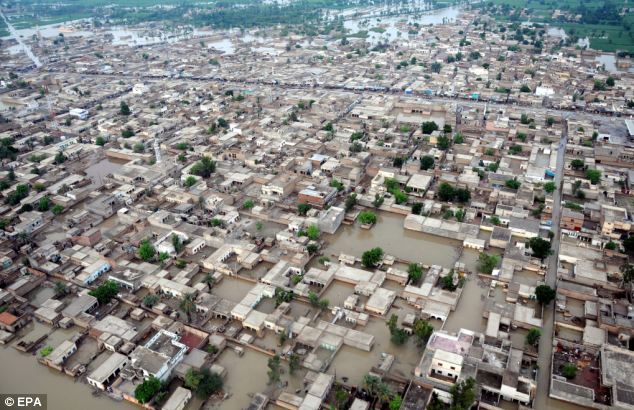
Pakistan Flood
Image Credit: EPA
The worst Asian Monsoon rains in decades continued to devastate Pakistan through the month of August (see also the July Global Hazards report for more detail on initial flooding and destruction). The United Nations Secretary General toured the aftermath and declared that he had never witnessed such devastation. Across the country more than 1,600 people were killed by the floods and six million were forced to flee their homes. In total, about 20 million were affected. Entire villages were submerged as an estimated 20 percent (62,000 square miles or 160,000 square km) of the country was under water. About 17 million acres (7 million hectares) of agricultural land was flooded and more than 200,000 animals were killed. Rivers in the southern province of Sindh overflowed their banks as floodwaters from the upper Indus River basin flowed southward toward the Arabian Sea. In Thatta, a city in Sindh with a population of about 300,000, about 95 percent of the residents were forced to evacuate toward the end of August. The floodwaters continued southward and submerged the last two towns—Khahre Jamali and Jati—on August 30th, before finally heading out to sea, a full five weeks after the torrential rains fell in the northern part of the country. Fears of water-borne disease were heightened as flood waters began to recede, leaving large pools of stagnant water. By the end of the month, tens of thousands were being treated in local clinics for illnesses such as dysentery and malaria. Some estimates placed total damages from the flooding at 15 billion U.S. dollars. It is interesting to note that the flooding in Pakistan was connected to the drought and heat wave conditions in Russia. An unusually strong polar jet stream shifted northward of Moscow and then plunged south toward Pakistan. This pattern remained in place for more than a month, bringing hot air into Russia and preventing rainfall. The low pressure systems that would normally bring precipitation were forced around the jet and southward into Pakistan, where they combined with heavy monsoon rains to help create the devastating floods. Also noteworthy, experts said that the scale of the disaster was exacerbated by deforestation and changes in land use over time in the impacted areas. The Asian Monsoon season lasts through September.
Midway through Nicaragua's rainy season—which typically begins around May 15th—at least 34 people were reported killed due to impacts from heavy rain and landslides, including 23 in August that perished after almost two weeks of torrential downpours. In total, an estimated 870 families were forced to evacuate their homes and about 84,000 people were affected.
On August 29th, copius amounts of rain triggered floods and mudslides that killed at least 12 people in the northern Turkish town of Gundogdu. Dozens of homes were detroyed and several roads were closed. According to an Associated Press report, deforestation to build tea plantations in the region has made the region prone to landslides.

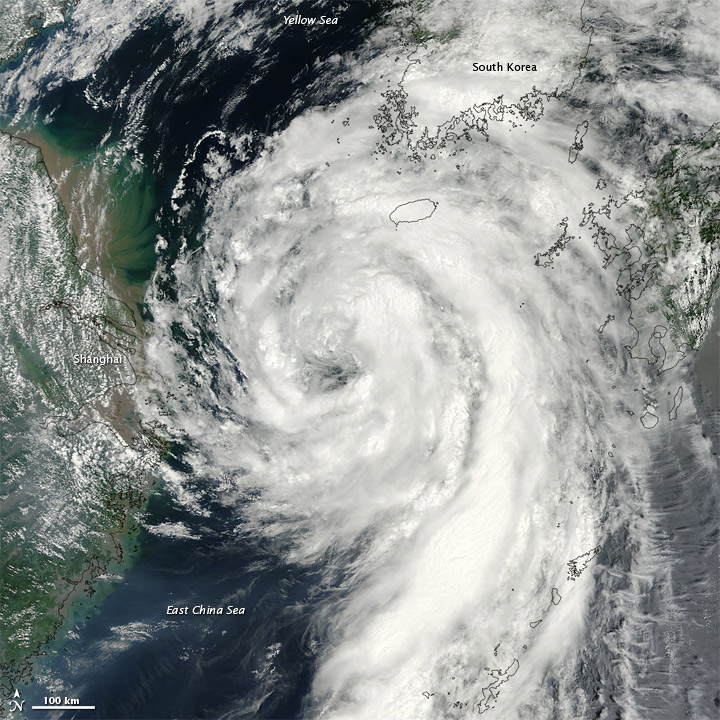
Satellite Image of Dianmu
10 August
Image Credit: NASA
Tropical Storm Dianmu made landfall in southern South Korea on August 10th, bringing torrential downpours and windy conditions. Five inches (120 mm) of rain fell over a three hour period, causing rivers to rise rapidly. Five people were killed due to the flooding. About 130 homes were flooded nationwide, 74 flights were cancelled, and 91 ferry trips suspended. The storm weakened and made a second landfall in Japan, where damage was not as extensive.
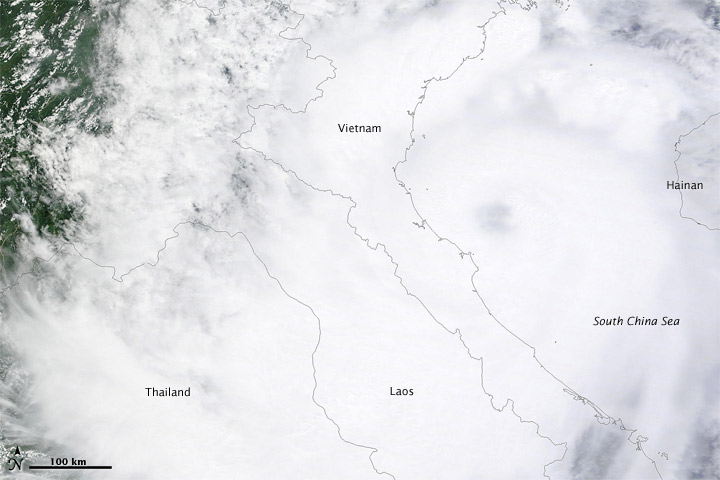
Satellite Image of Mindulle
24 August
Image Credit: NASA
Tropical Storm Mindulle made landfall along Vietnam's north-central coast on August 24th, near the city of Vinh. With maximum sustained winds of 70 mph (110 km/hr), Mindulle dumped up to 16 inches (273 mm) of rain near Vinh within a 12-hour period. Preliminary reports stated that ten people were killed, 47,000 homes were destroyed, and 158,000 acres (64,000 hectares) of rice fields were ruined.
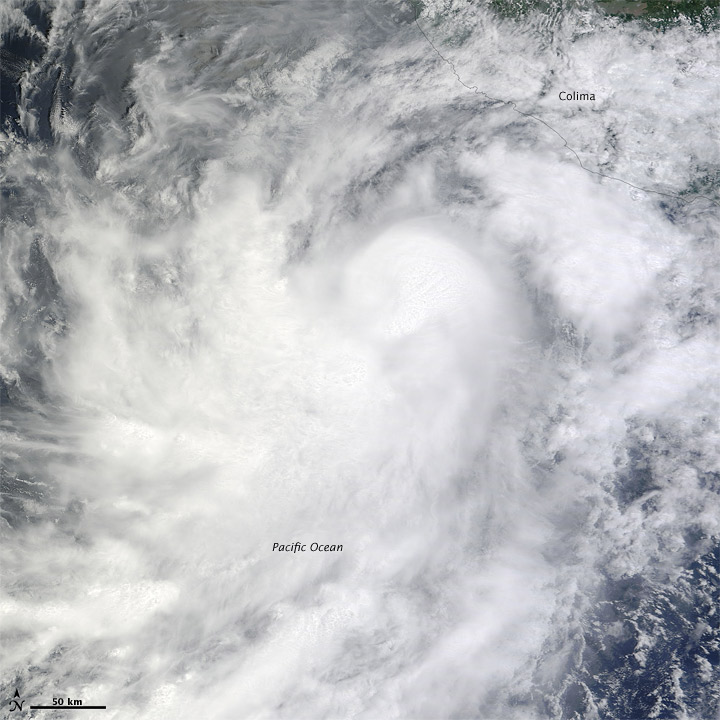
Satellite Image of Frank
25 August
Image Credit: NASA
On August 25th, Tropical Storm Frank brought heavy rains that triggered landslides over the southern Mexico state of Oaxaca, leaving four people dead. More than 100 towns were affected as the storm headed out to sea. As it moved away from land, Frank strengthened over water to become the third hurricane of the 2010 Eastern Pacific hurricane season, reaching Category 1 status, with top sustained winds of 90 mph (150 km/hr); however, the storm's path did not pose a threat to land and Frank dissipated on August 28th.

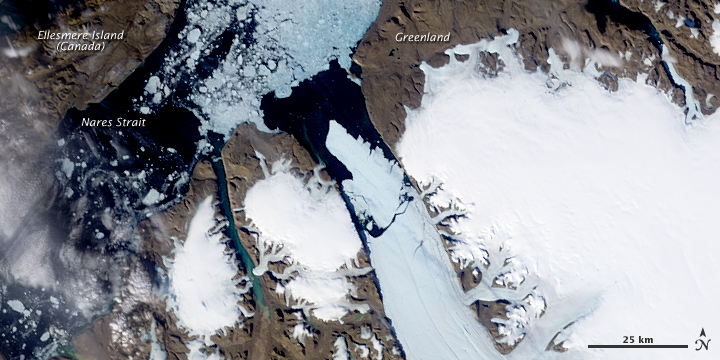
Petermann Iceberg Calving
5 August
Image Credit: NASA
On August 5th, a large chunk of ice broke off the Petermann Glacier in northwest Greenland into the Nares Strait. The ice piece was 97 square miles (251 square km) in size (roughly four times the size of Manhattan Island)—about one quarter of the floating ice shelf portion of the Petermann Glacier. Icebergs calving off the Petermann Glacier are not uncommon; however, the new iceberg was the largest in the Arctic since 1962. The ice was expected to move slowly southward through Baffin Bay toward the east coast of Canada, potentially posing a threat to shipping and fishing interests as it moved into busier waters.

During spring 2010, ocean waters off northwestern Indonesia were much warmer than normal for an extended period of time. Ocean temperatures reached as high as 93°F (34°C) in May—average temperatures in the region for this time of year are 86°F (30°C). The persisting very warm ocean temperatures led to massive bleaching in coral animals; bleaching occurs when algae living inside coral tissues are expelled, causing the coral to lose its coloration. According to media sources, the Wildlife Conservation Society reported that by early August up to 80 percent of those corals off the coast of Indonesia's Aceh province had been stressed and subsequently perished. Similar mass bleaching events also reportedly occurred in Sri Lanka, Thailand, Malaysia, Vietnam, and other parts of Indonesia. La Niña conditions were expected to intensify in coming months, warming the area's ocean waters and increasing the chances that the stress to the corals would continue. For more information about coral bleaching, please visit NCDC's "Did You Know" website.
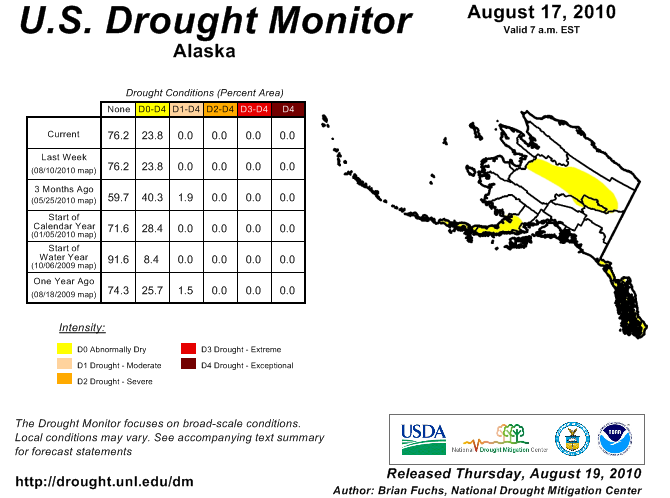
Alaska Dry Conditions
17 August
Image Credit: U.S. Drought Monitor
Drought and warm temperatures have been affecting the North American white spruce and birch trees in interior Alaska around Fairbanks. A forest ecologist at the University of Alaska, Fairbanks said that the effects of prolonged dry conditions and above-normal temperatures are transforming Alaska's boreal forest. The white spruce requires at least 11 inches (280 mm) of precipitation annually to survive—and more than that if temperatures rise above 60°F (15.5°C). The trees cannot survive temperatures above 70°F (21.1°C). According to the U.S. Drought Monitor, Fairbanks and surrounding areas have experienced abnormally dry conditions since the beginning of 2010. The April–May 2010 period in Fairbanks also saw near-record warmth. As reported above in the Drought and Wildfires section, temperatures broke the 90°F (32.2°C) mark at the Fairbanks airport on August 15th, according to records at the National Weather Service. By the end of August, there were 14 days in 2010 that hit 80°F (26.7°C) or higher at the airport. Temperatures across the eastern interior, stretching from Northway to Bettles, also saw record or near-record warmth during the August late-summer heat wave. The growing season in the region is now 120 days, 50 percent longer than a century ago. This means that there is a shorter period for snow to accumulate and a longer period of time between snowmelt and summer rains, factors that combine to produce more intense dry conditions. Birch trees in the area, once thought to be able to cope with a changing climate, are proving to be susceptible as well. In August, birch trees on the University of Alaska, Fairbanks campus showed indications of leaf scorch, the last visible symptom before a tree dies, according to the forest ecologist.
 NOAA's National Centers for Environmental Information
NOAA's National Centers for Environmental Information
